Trees and Shrubs with White Berries – Identification Guide
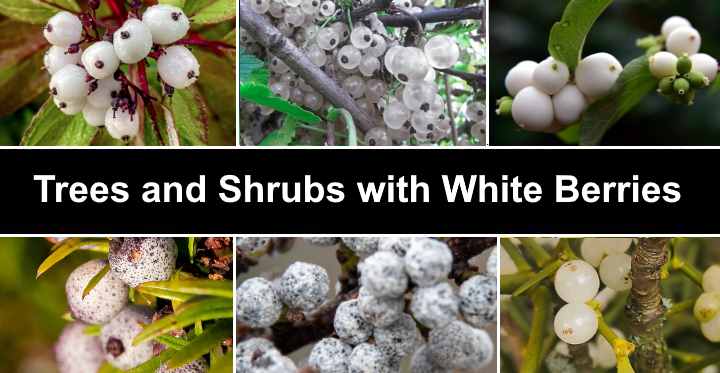
Trees and shrubs with white berries can add beauty and interest to gardens. White berries contrast nicely with the dark green foliage of many trees and shrubs. Shrubs with clusters of white fruits enhance the aesthetic appeal of garden landscapes. But they also provide vital food for wildlife and birds in late summer, fall, and winter. While some white berries on trees and shrubs are edible, you must be careful as many are poisonous to humans.
Several varieties of trees and shrubs produce clusters of white berries. For example, several red twig dogwood shrubs (Cornus) and white currant shrubs (Ribes sativum) produce clusters of white berries in summer and fall. Also, varieties of mulberry (Morus alba) and chinaberry (Melia azedarach) trees have white berries.
Planting trees and native shrubs with white berries can add contrasting colors to your garden landscape. The plants can be an attractive focal point, hedge, foundation planting, or specimen plant.
This article provides an overview of trees and shrubs with white berries. You will learn how to identify white-fruiting trees and shrubs to enhance your front or backyard aesthetics.
White Berry Identification
Knowing the plant type is vital to identifying white berries on trees and shrubs. Identification requires looking at the tree or shrub’s leaf shape, growth habit, and type of fruit. Also, flower shape and bloom time can be helpful indicators of the tree or shrub variety.
Some white berries are small round fruits growing in clusters and appear in late summer and fall. Other trees and shrubs have white berries resembling blackberries.
Why It’s Vital to Identify Trees and Shrubs with White Berries
It is important to be careful when identifying trees and shrubs with berries. Many white berries on shrubs and trees are poisonous fruits and can cause severe intestinal pain if consumed. Therefore, before consuming wild white berries, it’s crucial to correctly identify the type of white fruit.
Trees and Shrubs with White Berries — Identification Guide with Pictures
Please read on to find our comprehensive list of shrubs producing spectacular white berries.
Red Twig Dogwood Shrubs (Cornus)

Red twig dogwood shrubs in winter
Red twig dogwood shrubs have spectacular, vibrant red stems producing white clusters of berries in summer. Red-barked dogwoods feature dark green leaves, showy white flowers, and foliage that turns attractive purple, yellow, and red shades in the fall, adding to their appeal. The multi-stemmed shrubs naturalize easily in North American landscapes.
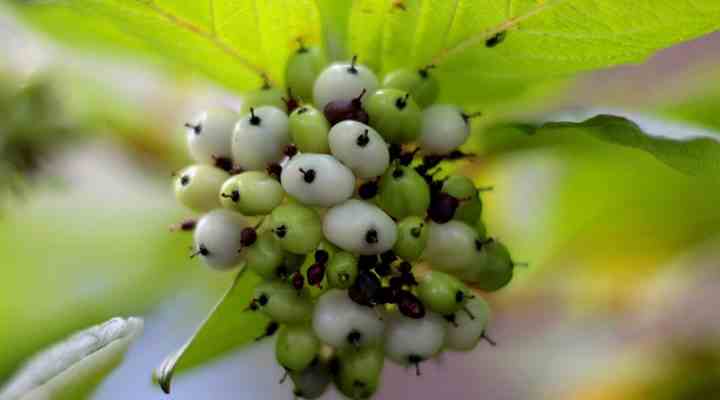
Red twig dogwood berries
With their vibrant red, vertical stems, dogwood shrubs provide plenty of color to winter landscapes. They grow up to 9 ft. (2.7 m) tall and wide. They are easy to care for and provide vibrant colors in every season. You can grow dogwood shrubs as a living fence or border or plant them along streams or ponds for their soil erosion control abilities.
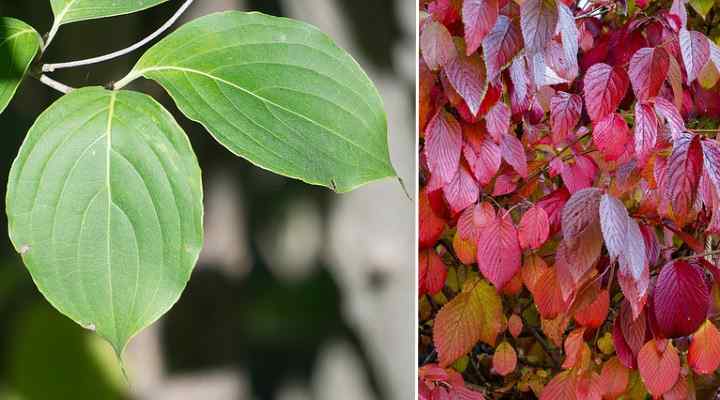
Dogwood leaves turn beautiful reddish color in autumn
Here are three eye-catching dogwood shrubs that have white berries:
Tatarian Dogwood (Cornus alba): This suckering deciduous shrub features clusters of white berries, showy red stems, and stunning red-purple foliage in the fall. They grow 8 to 10 ft. (2.4 – 3 m) tall and wide.

Cornus alba berries and autumn foliage
Red Osier Dogwood (Cornus sericea): This beautiful white-fruiting shrub has intense red stems in winter. Other attractive features of the shrub are its showy white, sometimes blue-tinged berries, variegated summer foliage, and leaves that turn rich red-purple in the fall. Also called the American dogwood, this species is fast-growing and grows 5 to 13 ft. (1.5 – 4 m) tall.
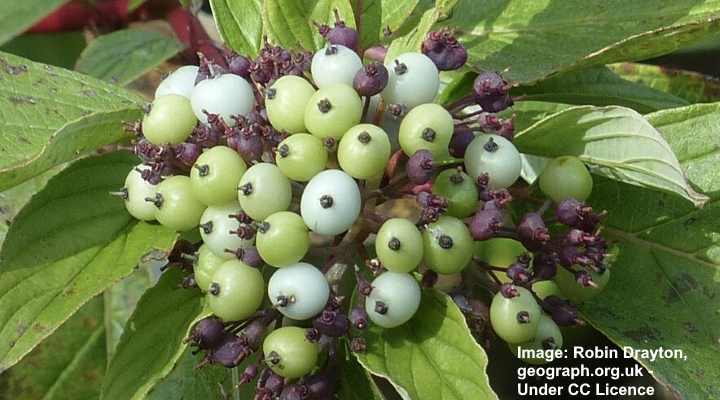
Cornus sericea berries
Bailey Red Twig Dogwood (Cornus sericea ‘Baileyi’): This fast-growing red-twig dogwood cultivar, like all dogwoods, tolerates moist, swampy soils. Its ornamental features are clusters of white berries, bright red winter stems, and purple foliage in fall. Growing 5 to 6 ft. (1.5 – 1.8 m) tall, the ornamental Bailey’s red twig dogwood shrub is suitable for small garden landscapes.
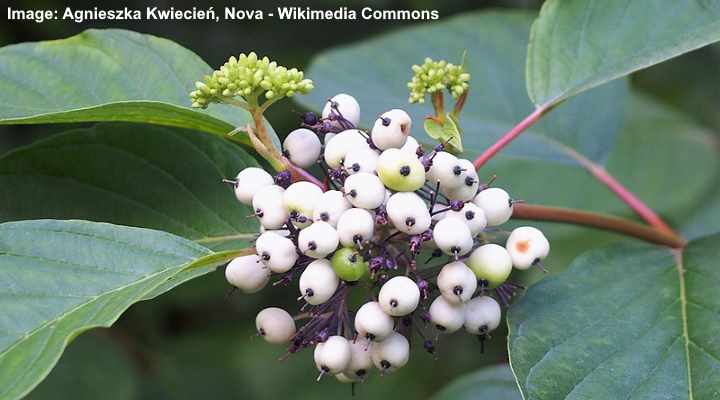
Cornus sericea baileyi berries
- USDA Planting Zone: 3 to 8
- Sunlight: Full sun to partial shade
- Mature Size: Typically 6 to 10 ft. (1.8 – 3 m) tall and wide, depending on the type
Further reading: Red Twig Dogwood Shrubs: Types, Leaves, Bark (Pictures) – Identification.
White Berry Nandina (Nandina domestica)

White berry nandina is a broadleaf, evergreen shrub with clusters of creamy-white berries. This ornamental shrub features feathery dark green leaves, golden yellow fall colors, and whitish or creamy-yellow berries. The shrubs grow up to 8 ft. (2.4 m tall) and are resistant to deer.
The clusters of white berries appear in spring and may persist until winter. They create a stunning contrast against the dark foliage. You can grow white berry nandina as a specimen plant, front-of-house planting, or mixed shrub border.
It’s good to note that the white berries contain hydrogen cyanide and are highly toxic to humans and wildlife.
Also called heavenly bamboo, here are descriptions of two outstanding nandina shrubs:
Nandina domestica var. leucocarpa: This evergreen shrub has pinnate leaves with lanceolate leaflets. The eye-catching ornamental feature of the shrub is its creamy-white or pale yellow round fruits appearing in late spring and early summer.
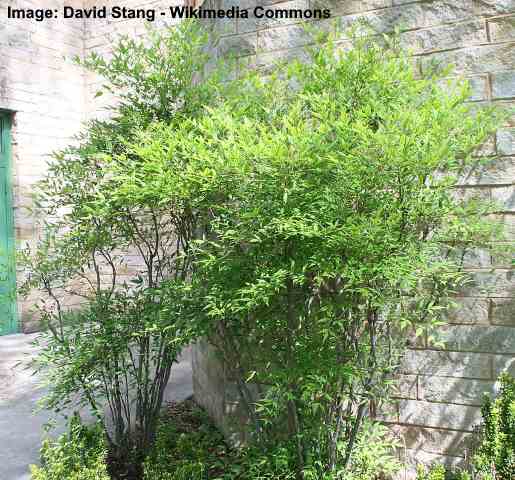
Nandina domestica var. leucocarpa
Nandina domestica ‘Alba’: This white-berried shrub forms a dense mound with fragrant white flowers in the summer and clusters of small, spherical white berries on show from late spring through winter.
- USDA Planting Zones: 6 to 9
- Sunlight: Partial shade to full sun
- Mature Size: 4 to 8 ft. (1.2 – 2.4 m) tall and 2 to 4 ft. (0.6 – 1.2 m) wide
White Currant (Ribes sativum)

White currant is a deciduous shrub that produces clusters of small, translucent, edible white berries in the summer. This thornless shrub features lobed, dark green leaves and tiny greenish-white flowers in the spring. The white berries are slightly smaller than traditional red currants and have a sweet-tart flavor.
White currant bushes grow to a height of 3 to 6 ft. (0.9 – 1.8 m) and have a compact, rounded shape. They are a great addition to gardens and landscapes as ornamental plants or for their edible fruit. The clusters of white berries also attract birds and wildlife.
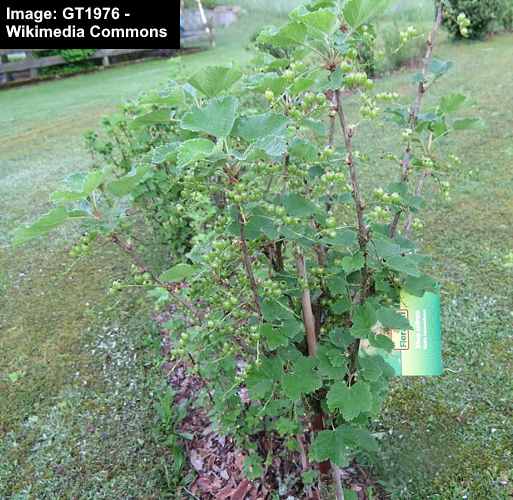
White currant shrub
- USDA Planting Zone: 4 to 8
- Sunlight: Full sun to partial shade
- Mature Size: 3 to 5 ft. (0.9 – 1.5 m) tall and wide
Common Snowberry (Symphoricarpos albus)

Common snowberry bushes are cold-hardy deciduous plants noted for their clusters of small, round, white berries. Thriving in the shade, the small flowering shrub features arching branches, bell-shaped pink and white flowers, and snow-white berries. The white-fruiting shrub provides ornamental value to landscapes and attracts birds and wildlife.
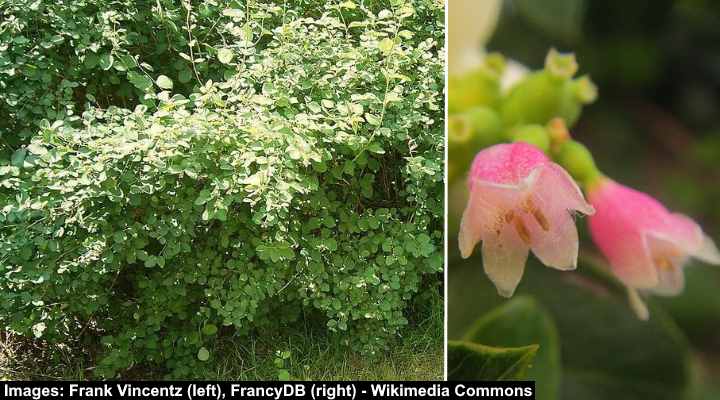
Common Snowberry shrub and flowers
Common snowberry plants grow up to 6 ft. (1.8 m) tall and wide. The attractive shrub performs well as a privacy screen, hedge, foundation planting, or shrub border. It spreads through suckers, creating dense thickets of bluish-green foliage in gardens, adding a touch of color to winter landscapes.
It is important to note that while the snowberry fruits are attractive to birds, they are toxic to humans and should not be consumed. Common snowberry shrubs are a great choice for shady gardens, naturalized areas, or as part of a wildlife garden.
- USDA growing zones: 3 to 7
- Sun exposure: Full sun, partial shade, and deep shade
- Mature Size: 3 to 6 ft. (0.9 – 1.8 m) tall and wide
Mistletoe (Viscum album)

Mistletoe is a parasitic evergreen shrub with poisonous white berries that grows on trees. The small shrub forms nest-like thickets in tree branches. It’s characterized by leathery, strap-shaped leaves, small, sticky white berries, and tiny, inconspicuous yellowish-green flowers. The white-fruiting shrub grows up to 1 ft. (0.3 m) wide.
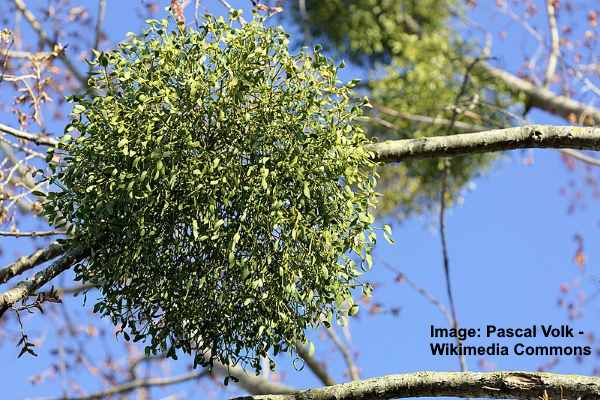
Mistletoe parasitic shrub
Mistletoe is a unique plant as it derives its nutrients from trees. It’s common in Europe and rarely seen in North America. It grows on lime, hawthorn, oak, poplar, and apple trees, attaching to tree branches. The plant plays an important role in Christmas decorations and traditions.
In addition to its cultural significance, mistletoe also boosts biodiversity in landscapes. The berries are a valuable source of food for birds. However, the white berries are highly toxic for humans and can be potentially fatal if ingested.
- USDA growing zones: 6 to 9
- Sun exposure: Full sun or partial shade
- Mature Size: 12” to 40” (30 – 100 cm) wide
White Beautyberry (Callicarpa dichotoma f. albifructa)

White beautyberry is a small, compact, ornamental shrub with spectacular pure white berries. This deciduous shrub features elliptic green leaves and pale pink flowers on arching stems. The dense clusters of unusual white berries appear in fall and persist through late winter.
White beautyberry shrubs grow up to 4 ft. (1.2 m) tall. It’s easy to grow and requires little maintenance. The white-fruiting shrub is also pest and deer-resistant and can withstand drought periods. The white berries are a winter food source for birds and add a touch of elegance to garden landscapes.
Common landscaping uses for white beautyberry shrubs include borders, hedges, screens, foundation planting, or as an accent plant. It also performs well in containers to add color and texture to patios or deck areas.
Callicarpa americana ‘Lactea’ is a stunning white beautyberry cultivar native to North America. This shrub has an upright and spreading habit, with attractive, white, spherical berries growing in clusters along its stems. These brilliant white berries contrast with the dark green foliage in native plant gardens.
- USDA Planting Zones: 5 to 8
- Sunlight: Full sun to partial shade
- Mature Size: 3 to 4 ft. (0.9 – 1.2 m) tall and 4 to 5 ft. (1.2 – 1.5 m) wide
Northern Bayberry (Myrica pensylvanica)

Northern bayberry is known for its white or grayish-silver berry-like drupes. The rounded shrub features leathery, dark green deciduous leaves that have a pleasant, aromatic scent when crushed. It blooms in spring with greenish or yellowish flowers. Its white berries have a scented, waxy coating used to make candles.
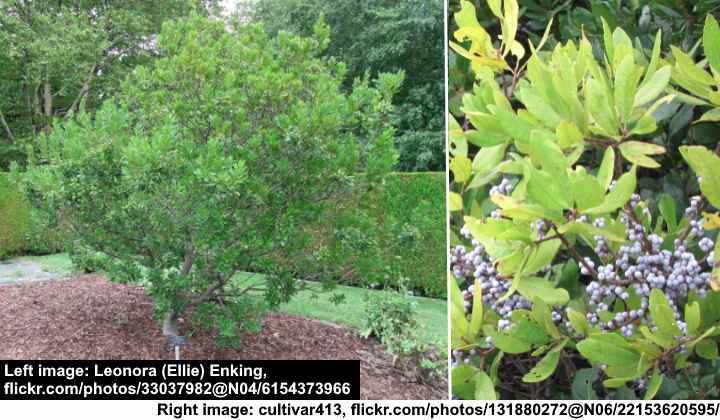
Northern bayberry shrub
Northern bayberry shrubs grow up to 10 ft. (3 m) tall and wide. The multi-stemmed shrub tolerates harsh growing conditions—drought, salt spray, shade, and sandy, dry soils. Due to its dense foliage, it’s a good landscaping plant in coastal areas as an informal hedge or screening plant. Additionally, the deep root system of northern bayberries helps prevent soil erosion.
- USDA Planting Zone: 3 to 7
- Sunlight: Full sun to partial shade in well-drained sandy soils
- Mature Size: 6 to 10 ft. (1.8 to 3 m) tall and wide
Prickly Heath ‘Snow White’ (Gaultheria mucronata ‘Snow White’)

Prickly heath ‘Snow White’ is an evergreen shrub with delicate white berries, glossy green leaves, and white flowers. It’s a low-growing, compact shrub with ornamental features. It blooms in late spring with urn-shaped white flowers and clusters of large white berries in the summer. The berries are approximately 0.25” (6 mm) across.
The compact shrub typically grows up to 3 ft. (0.9 m) tall. Its low-growing habit and spreading nature with evergreen foliage make it the perfect choice for ground cover, borders, or edging in gardens. The shrub’s evergreen leaves, contrasting with white flowers and berries, provide year-round interest as a unique focal point.
- USDA Planting Zones: 6 to 9
- Sunlight: Partial shade to full sun
- Mature Size: 2 to 5 ft. (0.6 – 1.5 m) tall wide
St John’s Wort (Hypericum x inodorum ‘Magical White’)

The ‘Magical White’ St John’s wort cultivar is a compact, upright shrub with luminous white berries in late summer and fall. Ornamental features of this deciduous shrub are showy clusters of bright yellow, saucer-shaped, starry, fragrant flowers, dark green leaves that persist until winter, and attractive white berries on red stems.
St John’s wort ‘Magical White’ grows up 3 ft. (0.9 m) tall and wide. It’s an excellent choice of white-fruiting shrub for planting in borders, growing as a hedge, or along a foundation line. It’s also tolerant of drought, deer, and common garden pests.
- USDA Planting Zones: 4 to 9
- Sunlight: Full sun to partial shade
- Mature Size: 2 to 3 ft. (0.6 – 0.9 m) tall and 3 ft. (0.9 m) wide
White Mulberry Tree (Morus alba)
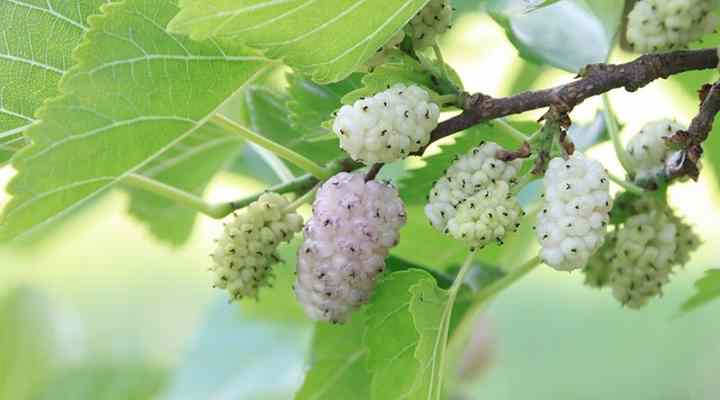
White mulberry is a fast-growing deciduous tree with abundant succulent white blackberry-like fruits in late summer. Although the berries are typically white, the deciduous tree can produce dark red, pink, or purple-black fruits. Other ornamental features of white mulberry are its dark green, glossy, heart-shaped leaves and small green flowering spikes.
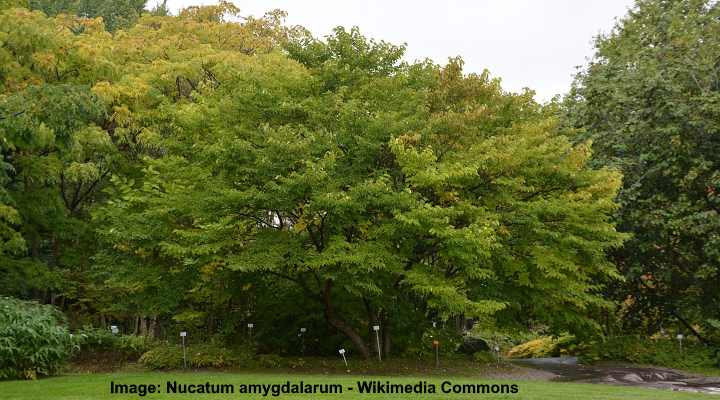
White mulberry tree
White mulberry trees grow rapidly, reaching heights of up to 50 ft. (15 m). The cold-hardy tree tolerates drought and heat and thrives in a variety of soil types, including poor soils. It’s a useful shade tree in northern climates and prized for its white juicy mulberries in the summer.
- USDA Planting Zones: 4 to 8
- Sunlight: Full sun to light shade
- Mature Size: 30 to 50 ft. (9 – 15 m) tall with a spreading canopy
White Berry Bush or Snowberry Tree (Flueggea virosa)

Snowberry tree is a fast-growing deciduous shrub or small tree with fleshy, edible white berry-like fruits. It’s a multi-stemmed shrub or small tree with thorny branches, reddish-brown bark, and oval green leaves. The brilliant white, fleshy, waxy fruits taste like peas and adorn the branches in the fall and winter.
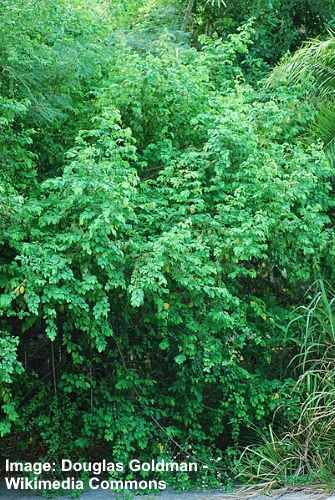
White berry bush / Snowberry tree
Also called white berry bush, the large shrub typically grows up to 13 ft. (4 m) tall with a spreading canopy. It’s useful in landscapes for screening, an accent plant, or a hedge. Its drought-tolerant properties make it ideal for planting waterwise gardens.
Even though its winter blooms are insignificant, snowberry shrubs attract late-season pollinators to gardens.
- USDA Planting Zones: 10 to 12
- Sunlight: Full sunlight in well-drained soil
- Mature Size: 5 to 13 ft. (1.5 – 4 m) tall and wide
Chinaberry Tree (Melia azedarach)

The chinaberry tree is a large, fast-growing tree with creamy-pale yellow, almost white, fleshy berry-like drupes. Attractive features of this deciduous tree are its pinnately compound leaves, lance-shaped leaflets, and clusters of five-petalled, star-shaped, fragrant lilac and white flowers. The small pale-colored fruits appear in summer and attract birds to garden landscapes.
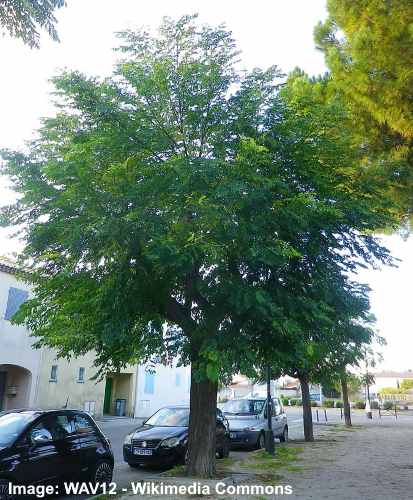
Chinaberry tree
Chinaberry trees can grow up to 40 ft. (12 m) tall and grow five to ten feet (1.5 – 3 m) annually during the first two years. The heat-loving, full-sun tree, with its dense, rounded canopy, is ideal as a shade tree in southern landscapes. Other names for the tree include Pride of India, syringa berry tree, Persian lilac, or white cedar.
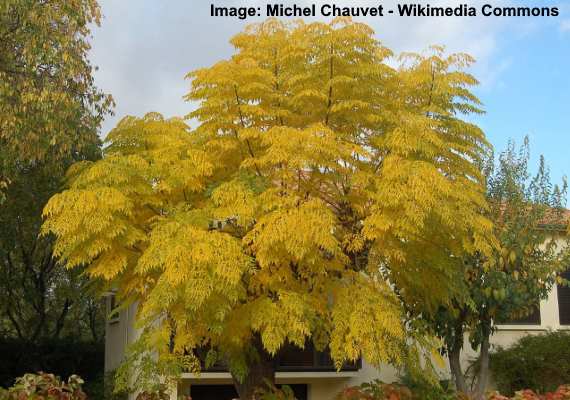
Chinaberry tree in autumn
Note: Some regions consider the chinaberry tree invasive, so check with local regulations before planting.
- USDA Planting Zones: 7 to 11
- Sunlight: Full sun
- Mature Size: 30 to 40 ft. (9 – 12 m) tall
Midgen Berry (Austromyrtus dulcis)

Native to Eastern Australia, the midgen berry is a small, spreading shrub producing sweet, edible, white berries. This low-maintenance shrub features small, lanceolate leaves, white flowers 0.39” (10 mm) across, and small, round, tasty berries. The attractive berries are white with small blue-black spots and contain up to nine seeds.
Midgen berry white-fruiting shrubs grow up to 6.5 ft. (2 m) tall. The fleshy berries are aromatic and have a sweet, peppery, or ginger flavor. Its compact growth makes it an ornamental shrub for smaller gardens or an accent plant in larger landscapes.
Midgen berry shrubs tolerate coastal conditions and some drought. Although it prefers full sun, it grows well as white-flowering ground cover in shaded areas.
- USDA Planting Zones: 9 to 11
- Sunlight: Full sun to partial shade
- Mature Size: 3 to 6.5 ft. (0.9 – 2 m) tall and wide
White-Fruited Rowan Tree (Sorbus glabrescens)
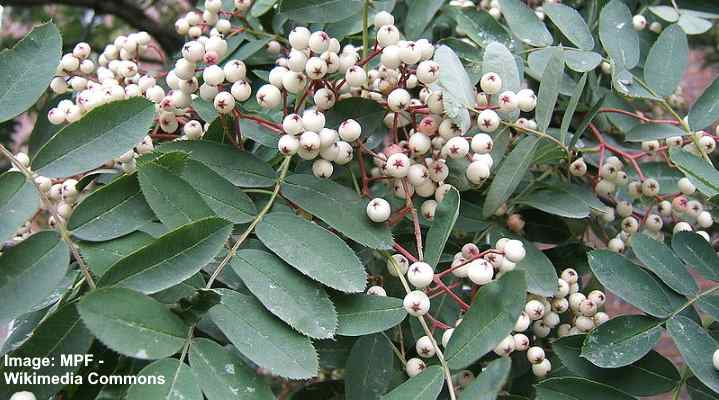
Also called glabrous mountain ash, this deciduous rowan tree is native to China and has abundant clusters of white berries. The identifying features of this rowan tree are its glaucous blue-green foliage, white flowers with yellow stamens, and white fruits hanging on bare branches in the winter.
- USDA Planting Zone: 2 – 6
- Sunlight: Full sun to partial shade
- Mature Size: 26 to 49 ft. (8 – 15 m) tall
Related articles:
